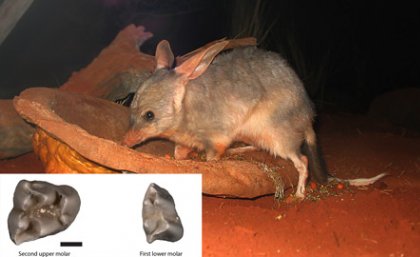
An ancient fossil of the bilby, Australia’s answer to the Easter rabbit, has been discovered at the Riversleigh World Heritage site in north west Queensland.
The 15-million-year-old fossil of the long-eared marsupial, found by palaeontologists from The University of Queensland and the University of New South Wales, confirms that bilbies evolved millions of years earlier than was previously known.
Lead researcher Dr Kenny Travouillon, from UQ’s School of Earth Sciences, said the finding would increase understanding of the fossil record and the evolution of Australian marsupials.
“More generally, by understanding how Australia’s vertebrates and ecosystems have evolved through time with the changing climate, we can better predict their responses to future climate change and better protect the more endangered lineages against extinction,” Dr Travouillon said.
DNA studies on related species had predicted that the bilby had evolved about 25 million years ago, when it separated from its closest relative, the bandicoot.
Until now, the oldest fossil of the endangered bilby was only about five million years old.
“The species that we have discovered is about 15 million years old, which is more in accordance with the DNA data and will provide insight on how bilbies have evolved over time and adapted to changes in the Australian environment,” Dr Travouillon said.The species has been named Liyamayi dayi, which is derived from the Aboriginal Waanyi people’s language and means ‘day’s round tooth’.
The “day” refers to UQ alumnus and geologist Dr Robert Day, who funded Dr Travouillon’s postdoctoral fellowship at the School of Earth Sciences.
Riversleigh is famous for previous discoveries of extinct Australian animal fossils, such as carnivorous kangaroos, the predecessors of Tasmanian tigers, and tree-climbing crocodiles.
Dr Travouillon and his team, also recovered fossils of a 15-million-year-old species related to modern bandicoots from the same area.
“Just like the bilbies, the previously oldest known ancestor of the modern bandicoots was also about five million years old, and hence this finding also pushes back their age,” Dr Travouillon said.
As the new bandicoot species was found in an unusual time period -- almost crashing in a time period where it was least expected -- the team has named it ‘Crash bandicoot’, after a video game character.
The fossils were discovered several years ago, and the results of subsequent research has now been published in the Journal of Vertebrate Paleontology.
About the Robert Day Postdoctoral Research Fellowship
Dr Robert Day graduated from The University of Queensland with a Bachelor of Science with First Class Honours in Geology and Mineralogy in 1961. He spent most of his career as a geologist in the Geological Survey of Queensland in the Queensland Department of Mines. A series of promotions saw him become Chief Government Geologist and Director of the Geological Survey of Queensland and ultimately Director-General of the Department of Mines and Energy. On completion of his government service in 1998, he became a pioneer in the coal seam gas industry. Dr Day has donated significant funds to establish the Robert Day Postdoctoral Research Fellowship in Palaeontology and Stratigraphy in the UQ School of Earth Sciences to promote palaeontological research in Queensland. UQ and the School of Earth Sciences are grateful for Dr Day’s generosity, which has made research such as the one above, possible.
Media: Dr Kenny Travouillon, +61 (0) 414656978, k.travouillon@uq.edu.au, Engagement Officer Aarti Kapoor, +61 (0) 449863208, a.kapoor@uq.edu.au.
.jpg)









